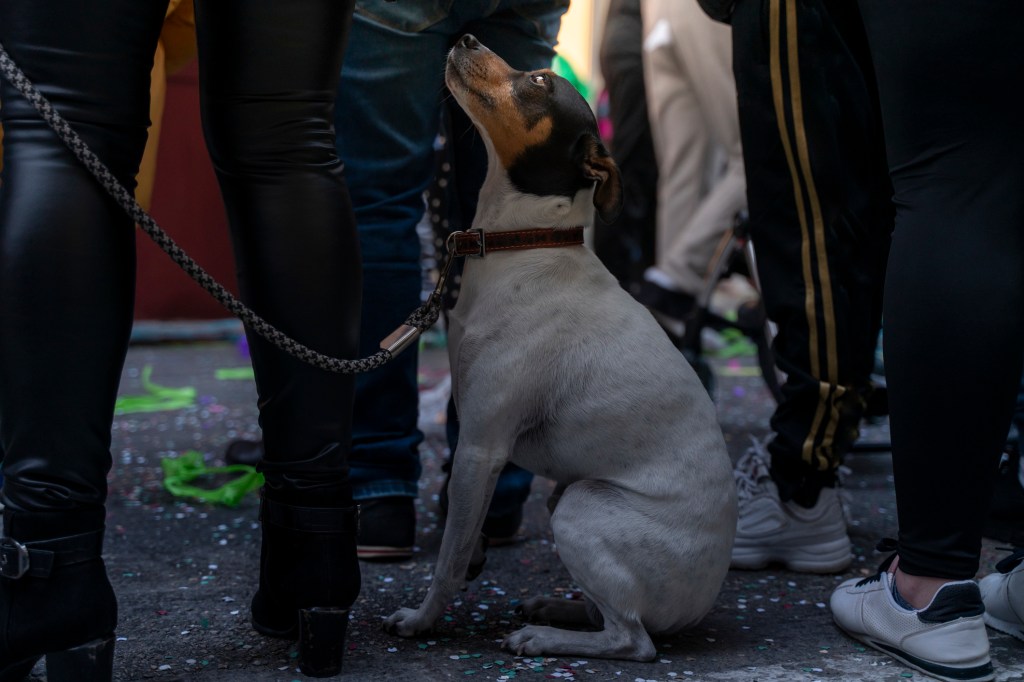Anxiety in dogs is similar to social anxiety in people. As such, it’s an extreme fear or stress related to social situations. Dog anxiety is normal for many dogs and can cause changes in behavior when exposed to unfamiliar people, animals, or places. But at what point does this shift from general stress to deeper social anxiety issues? Knowing the signs of anxiety in dogs can help dog parents address problems early on before they intensify.
Anxiety vs. depression
While anxiety and depression may look dramatically different, they can both contribute to your dog’s well-being. Signs of depression can include lethargy; lack of interest in toys, treats, or activities; and changes in appetite.
Causes of dog depression
- Loss of a companion (animal or human)
- Major environmental changes
- Boredom/lack of mental stimulation
- Pain or illness
- Poor diet
Dog anxiety symptoms
Not to be confused with separation anxiety, extreme reactions when meeting strangers is one of the most common red flags for social anxiety in dogs. This can include aggressive barking, lunging, or hiding behind their owner when new people approach. Some anxious pups may even refuse to walk or are too distracted to obey commands when in public areas.
Overly stressed body language like a tucked tail, flattened ears, or yawning outside of feeling tired are other symptoms. Social events also may lead to diarrhea, vomiting, or loss of appetite due to the mental strain.
Signs of anxiety
- Restlessness, agitation
- Pacing, shaking, panting
- Clinging to/following owner
- Hiding or attempting to escape
- Sensitivity to noise or touch
- Destructive behaviors
Why dogs develop social fears
Genetics play a role, with shy parent dogs more likely to pass along those tendencies. Insufficient socialization as a puppy can also contribute to failing to introduce enough positive interactions. Moreover, trauma from a bad experience like abuse can instantly create negative associations as well.
Also, certain medical conditions may seemingly manifest as social anxieties. Thyroid disorders, adrenal disease, and chronic pain are all tied to behavior changes that present similarly to anxiety around other animals or strangers.
Dog breeds susceptible to social anxiety

Certain breeds of dogs are considered more genetically prone to developing social anxiety and fearfulness. Some breeds and backgrounds known to be vulnerable to social anxiety issues include:
- Shy, “nervous” breeds: This includes breeds like Greyhounds, various Terriers, herding breeds, livestock guardian dogs, Chihuahuas, Papillons, and many toy dog breeds. They tend to startle more easily or be suspicious of new things.
- Fearful rescue or shelter dogs: Dogs confined long-term or previously abused often exhibit heightened fear and anxiety due to negative experiences. Their past trauma shapes nervous dispositions.
- Lack of early socialization: All puppies require exposure to various people, places, and stimuli during a prime developmental stage for proper social skills to emerge. Missing out contributes to wariness later on.
- Older and senior dogs: Advancing age can bring about confusion, neurocognitive issues like dementia or canine cognitive dysfunction, and hearing or vision decline that can manifest like social anxiety in dogs unaccustomed to the changes.
While genetics contribute to a dog’s base temperament, environmental factors play an enormous role in determining social aptitude. Boosting confidence through reward-based training, avoiding punishment for nervous behaviors, and maintaining exercise or routines can help dogs prone to social issues. It’s often a management issue more than anything inherently “broken.” The key is knowing and accommodating limits unique to that individual dog’s needs.
What pet parents can do about dog anxiety
The first step is scheduling a veterinarian exam to rule out a medical trigger. If health isn’t the culprit, begin logging details about surroundings and situations when the anxiety emerges. This helps identify specific triggers to address.
From there, focus on very gradual exposure therapy. Start introducing the dog to their trigger from a reasonable distance where they notice but don’t react negatively. Reward calm behavior with high-value treats socialization.
Use this same approach to slowly decrease the distance over time, spending many sessions moving to closer interactions with the trigger. Remember, patience is vital. In particular, forcing anxious pups into stressful situations generally worsens reactions long-term.
Dog anxiety medications
In some cases, prescription anti-anxiety medications like Trazodone may help enough for dogs to relearn old associations. Supplements like pheromones or CBD are also safer first options. Some other anxiety medications include:
Living with a socially anxious dog

While social anxieties likely can’t be fully “cured,” they can be successfully managed. This allows anxious dogs to live happy, enriched lives with the right owner commitment.
Stay alert to surroundings on walks to avoid known triggers. Skipping crowded events reduces unnecessary stress as well. Instead, focus playtime and exercise on predictable environments using known people. Keep introductions to strangers or new places very limited and controlled.
With some adjustments, pet parents can continue to enjoy their bond with their dog. What’s more, having realistic expectations of a canine’s social abilities will reduce anxiety for everyone. That said, a dog owner should know when actively challenging those boundaries is both necessary and unnecessary.
The key is learning the individual dog’s signals and respecting when they hit capacity by removing them from an untenable situation. While social anxiety seems strictly behavioral, it’s no less real of a struggle. Paying attention to a dog’s distress and addressing the root cause is essential, just as it would be for a human family member battling similar issues. As in most cases, patience and compassion go a long way.
Adblock test (Why?)
Powered by WPeMatico